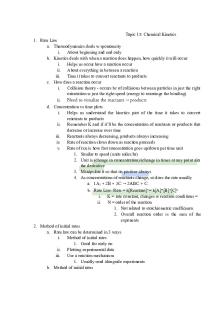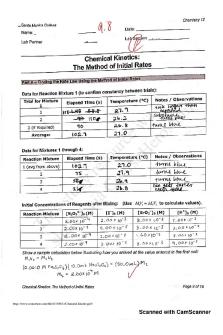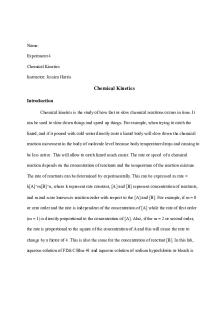Chemical Kinetics - Summary General Chemistry Ii PDF

| Title | Chemical Kinetics - Summary General Chemistry Ii |
|---|---|
| Author | Karina Kunwar |
| Course | General Chemistry Ii |
| Institution | Jacksonville State University |
| Pages | 6 |
| File Size | 392.5 KB |
| File Type | |
| Total Downloads | 93 |
| Total Views | 152 |
Summary
It is brief summary of the course....
Description
Chapter 15 Chemical Kinetics
1. The rate of chemical reaction – the change in the amounts of reagents (or products) divided by the change in time. For the reaction of hydrogen and iodine, H2(g) + I2(g) 2 HI(g) , the reaction rate is defined as 1 [HI] [H 2 ] [I 2 ] 2 t t t Rate= Note that reaction rate is a positive number, therefore, negative sign must be added when reagents are used (because their concentrations decrease) and positive sign when products are used (because concentrations of products increase). Factor ½ is due to stoichiometry because two moles of HI are made from one mole of H2 and I2. Concentration of hydrogen and the reaction rate (magnified 25 times) for the above reaction, is shown below
2. The instantaneous reaction rate - this is the slope of the concentration curve plotted against the reaction time. For general reaction: aA bB cC dD , the reaction rate is defined as: 1 [A] 1 [B] 1 [C] 1 [D] b t c t d t Rate = a t 3. Measuring reaction rates determine concentration of reagents or products as a function of time, using suitable analytical techniques, for example, absorption of light or chromatography. 4. The rate laws: The reaction rate depends on concentration of reagents. Let’s consider reaction A products (for example, decomposition of sucrose into glucose and
fructose in acidic solution). We also assume that the rate of incverse reaction is very small. Then the rate law is: n Rate = k [A]
n = 0 - the reaction is zero order n = 1 - the reaction is first order n = 2 - the reaction is second order Examples: (a) zero-order reaction: sublimation is a zero order reaction: A(solid) A(gas) because sublimation takes place from the surface, so the number of available molecules at a given time is constant. (b) first order reaction – cyclopropane CH3—CH==CH2 (c) second order reaction: NO2(g) NO(g) + O(g) 5. Overall reaction order: For reaction aA + bB cC + dD , the reaction rate is defined as: n m Rate = k [A] [B] , and n + m is the overall reaction order. Examples: NO2(g) + CO(g)
NO(g) + CO2(g)
H2(g) + I2(g) 2 HI (g)
Rate =
Rate =
k[H2 ]1 [I2 ]1
2H2(g) + 2 NO(g) N2(g) + 2H2O(g) Rate =
k[NO2 ]2 [CO]0
overall order = 2
overall order = 2 k[H2 ]1 [NO]2
overall order = 3
6. Rate laws and concentration of reagents as a function of time: a) Zero-order reaction
Rate =
[A] k[A]0 t
[A]t kt [A]t 0
[A] t1/2 t 0 2k
b) First-order reaction Rate =
[A] k[A]1 t
ln[A]t kt ln[A]t0
t1/2
ln 2 0.693 k k
c) Second order reaction:
Rate =
[A] k[A]2 t
1 1 kt [A]t [A]t0
t1/2
1 k [A]t0
7. Graphical representation
8. Determine the reaction rate using MS Excel: graph concentration vs. time. If you get a straight line, than the reaction is zero-order. If not, then the reaction could be first or second order. Then plot logarithm of concentration vs. time. If you get a straight line,
then the reaction is first order. If not, then graph inverse of the concentration vs. time. If you get a straight line with POSITIVE slope, then the reaction is the second order. Example: N2O5(g) NO2 (g) + NO3(g) Time(s)
0
[N2O5] (M) 1.00 0
25
50
75
100
125
150
175
200
0.82 2
0.67 7
0.55 7
0.45 8
0.37 7
0.31 0
0.25 5
0.21 0
9. The effect of temperature on reaction rate: Rate = k [A]n , and the rate constant, k depends on temperature:
k Ae
Ea RT
- Arrhenius equation
where A is the frequency collision factor and Ea is the activation energy. The activation energy is the energy barrier that reagents must “climb” in order to transform into products.
10. How to measure the activation energy: E 1 E ln k ln( A) a a RT R T k Ae Therefore, we must measure the reaction rate constant as a function of temperature, then graph natural logarithm of the rate constant vs. temperature inverse. Example: T(K)
310
320
330
340
350
k(1/s )
0.0043 4
0.014 0
0.042 1
0.118 0.31 6
1 We graph ln(k) vs. T and get the following graph:
1 ln( k ) We see that -1162 T + 32.055. Ea E Therefore, R 1162 and ln( A) = 32.055, or: a 139.8 J/(mol), and the frequency factor A = 8.34x1013 collisions per second. 11. Catalysis – heterogeneous catalysis (takes place on a surface of a solid catalyst) and homogeneous catalysis – a catalyst is in the same phase as reagents. Examples – heterogeneous catalysis: car catalytic converters (Pt, Pd, Rh on ceramic support), synthesis of ammonia (Pt on metal support), hydrogenation of plant oils (nickel on ceramic support), cracking of heavy hydrocarbons (aluminum/chromium oxides on ceramic support). Homogeneous: decomposition of ozone, dehydration of alcohols by acids. 12. Enzymes – synthesis of starch and sugars from CO2 and water (+light), synthesis of biological compounds (for example, antibiotics, alkaloids, and numerous other compounds)....
Similar Free PDFs

Topic 15 Chemical Kinetics
- 5 Pages

Chemical Kinetics lab
- 9 Pages

Chapter 14- Chemical Kinetics
- 3 Pages

Chemical Kinetics-DR. ASM
- 44 Pages

Chemical Kinetics - lab report
- 4 Pages

Chem 17 - General Chemistry II
- 9 Pages
Popular Institutions
- Tinajero National High School - Annex
- Politeknik Caltex Riau
- Yokohama City University
- SGT University
- University of Al-Qadisiyah
- Divine Word College of Vigan
- Techniek College Rotterdam
- Universidade de Santiago
- Universiti Teknologi MARA Cawangan Johor Kampus Pasir Gudang
- Poltekkes Kemenkes Yogyakarta
- Baguio City National High School
- Colegio san marcos
- preparatoria uno
- Centro de Bachillerato Tecnológico Industrial y de Servicios No. 107
- Dalian Maritime University
- Quang Trung Secondary School
- Colegio Tecnológico en Informática
- Corporación Regional de Educación Superior
- Grupo CEDVA
- Dar Al Uloom University
- Centro de Estudios Preuniversitarios de la Universidad Nacional de Ingeniería
- 上智大学
- Aakash International School, Nuna Majara
- San Felipe Neri Catholic School
- Kang Chiao International School - New Taipei City
- Misamis Occidental National High School
- Institución Educativa Escuela Normal Juan Ladrilleros
- Kolehiyo ng Pantukan
- Batanes State College
- Instituto Continental
- Sekolah Menengah Kejuruan Kesehatan Kaltara (Tarakan)
- Colegio de La Inmaculada Concepcion - Cebu









